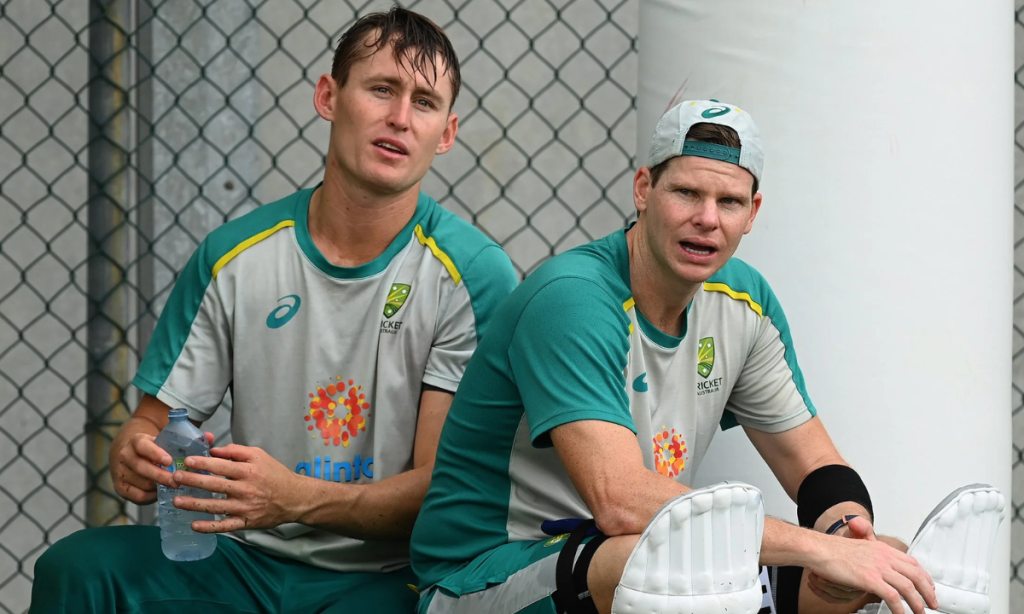In the cauldron of Test cricket, where every run counts and every dismissal is scrutinized, achieving 10,000 runs is a testament to a player’s longevity, skill, and resilience.
On January 29, during the series opener against Sri Lanka in Galle, Steve Smith not only added to his illustrious career but also etched his name into the annals of cricket history by reaching this monumental milestone.
With one decisive stroke, Smith moved from 9,999 to 10,000 Test runs, highlighting his status as one of the game’s greats.
However, the spotlight wasn’t just on Steve Smith’s personal triumph.
The Australian cricket stalwart also turned his gaze towards the future, identifying young talents who could follow in his footsteps and carve their own paths to 10,000 runs.
In a moment of candid reflection, Smith remarked, “It’s a good question. I think there’s a few people that can certainly tick it off. Marnus [Labuschagne] is about halfway there. Travis [Head] potentially. [Sam] Konstas is 19 and he could play for a long, long time potentially.”
This statement not only acknowledges the talent within the Australian squad but also sets a benchmark for what might be expected from these players in years to come.
The Modern Challenge of Batting
Smith’s journey to 10,000 runs, however, has not been without its challenges. He noted, “Far more difficult to bat on these surfaces with these Kookaburra balls than it was 10 years ago.”
This observation sheds light on the evolving nature of Test cricket in Australia.
The Kookaburra ball, known for its softer seam and less swing compared to the Dukes ball used in England, has made scoring runs a more arduous task.
Smith’s assertion is backed by statistics and personal experience, as he pointed out, “100 per cent it’s far more difficult to bat on these surfaces with these Kookaburra balls than it was 10 years ago. There’s no doubt in my mind. The stats would suggest that all batting averages [in Australia] are coming down and bowling averages are coming down.”
This changing dynamic of the game poses a significant challenge for the upcoming generation of cricketers, including those Smith mentioned.
The wickets over the last three years, as Smith elaborated, have been particularly tough on top-order batsmen.
“These wickets we’ve played on probably the last three years have been tough, particularly for top order players. You’ve got to have a lot of luck to score big runs to get 100 in a game and you need some luck.”
This statement underlines the unpredictability and the increased difficulty in amassing large scores in contemporary Test cricket.
The Path Forward for Young Talents
Marnus Labuschagne, already halfway to the 10,000-run mark, exemplifies what could be possible with consistency and adaptability.
His technical prowess and mental fortitude have made him one of the most reliable batsmen in the world.
Travis Head, with his aggressive yet calculated approach, has shown flashes of brilliance that could see him amass runs over a prolonged career. Meanwhile, Sam Konstas, at just 19, represents the future.
His inclusion in Smith’s conversation indicates not just potential but also the belief in his ability to navigate the complexities of Test cricket over an extended period.
The journey to 10,000 runs is fraught with challenges – physical, mental, and now, increasingly, environmental with the nature of pitches and the balls used.
Smith’s insights suggest that while the path is tough, it’s not insurmountable for those with the right blend of talent, resilience, and adaptability.
In Summary
As Steve Smith completed his 10,000 runs, he not only celebrated his personal achievement but also cast a hopeful eye towards the future of Australian cricket.
His comments serve as both an acknowledgment of the shifting sands of the game and a vote of confidence in the young talents who might one day join him in this exclusive club.
The road ahead is fraught with challenges, but with players like Labuschagne, Head, and Konstas, the legacy of Australian cricket seems in safe hands.

